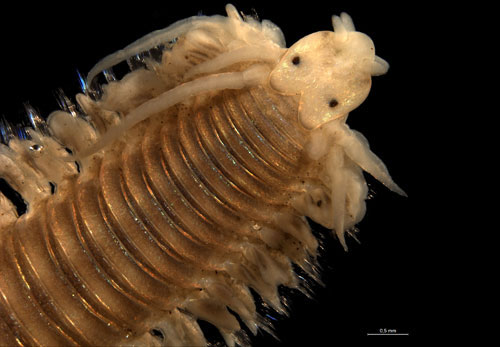
Contact
Biological mapping
Børge Holte
+47 77 60 97 53
Member of the expert group
Torkild Bakken
Communication advisor
Beate Hoddevik Sunnset
+47 55 23 85 16
+47 908 21 630

Published: 30.11.2012 Updated: 07.12.2012

This bristle worm belongs to the family Phyllodocidae, and is one out of many species found in the seabed samples collected in the MAREANO-surveys. (photo: Katrine Kongshavn, University of Bergen)
The bristle worms comprise a high proportion of the invertebrate animals living on top of, and within, marine bottom sediments. These animals are therefore important in order to obtain knowledge about benthic species richness and production. Not least, this extensive and diverse group of animals constitutes an important instrument for future measurements and documenting of climatic change in the North.
Many polychaetes found in MAREANO samples are already further studied by the expert group. Particularly exciting is that new species are discovered on the continental slope down towards the Norwegian Sea deep water. Bristle worms are often small animals, and there is often little difference between the various species. This makes identification even more challenging. Use of DNA barcoding is an important tool for clarifying the identification and discovering new species. Both species that are new within the regions sampled, and new to science have been found, and the probability is high that similar findings can be made in the remaining material.
- The goal of the project is to describe new species and new occurrences of bristle worms. We have a particular focus on the transition zone between the shelf and the deep sea where it seems to be a species change with depth, says Børge Holte responsible for the biological monitoring of MAREANO.
The expert group consists of Torkild Bakken from NTNU Museum, Jon A. Kongsrud from Bergen Museum, Eivind Oug from the Norwegian Institute for Water Research and Børge Holte IMR. In addition, invited specialists from Akvaplan-niva, Uni Environment, the Natural History Museum, University of Copenhagen, National Museum of Wales and the National Museum of Scotland are involved in the project.